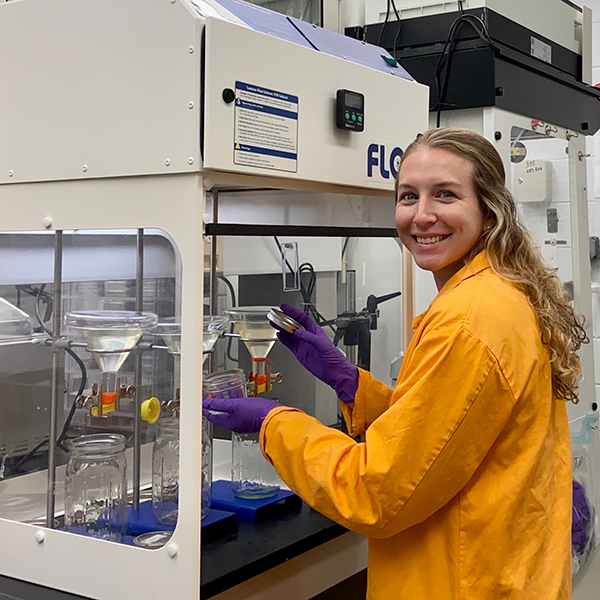Earlier this summer, a first-of-its-kind study, funded by Rhode Island Sea Grant, mapped the movement and accumulation of microplastics in Narragansett Bay, finding the highest concentrations near urban centers, which are shaped by river runoff and wind patterns. Read the full story here.
That research has helped build momentum well beyond the Bay. Increased visibility has drawn in new resources, including generous donations that equipped URI with an advanced LDIR (Laser Direct Infrared Spectrometer), a powerful tool for identifying plastics in environmental samples. This instrument was made possible by the generous support of Ava Wilson, URI Class of 2024.
“Rhode Island Sea Grant funding for this project and other studies was key to getting the information out and getting people interested,” says Coleen Suckling, associate professor at URI, who was part of the research team investigating microplastics in Narragansett Bay.
As plastic debris breaks down into increasingly smaller fragments and persists in the environment, the need for precise, efficient, and scalable detection methods continues to grow.

Sarah Davis, Ph.D., lead author in new study, processes seawater samples from Narragansett Bay to extract and isolate microplastics for analysis.
As microplastics get smaller, they become exponentially more abundant. If we were looking for the tiniest particles, we’d have to cut our sample size way down because there’d be so much more to detect. The labor would be undoable.
That’s part of the challenge with microplastics field research. It’s so labor intensive.
– Sarah Davis, Ph.D.
Microplastic pollution has become a significant global environmental concern, impacting marine, terrestrial, and atmospheric ecosystems. As plastic debris breaks down into increasingly smaller fragments and persists in the environment, the need for precise, efficient, and scalable detection methods continues to grow.
One major advancement is Laser Direct Infrared (LDIR) spectroscopy, which uses a Quantum Cascade Laser (QCL) to deliver rapid, automated, and highly sensitive analysis. Capable of detecting particles as small as 10–20 microns—roughly the size of fine sand or a pollen grain—LDIR offers enhanced wavelength accuracy and dramatically reduces analysis time for water, sediment, and biological samples, turning weeks of work into hours.
“These kinds of advancements are vital,” Suckling adds. “LDIR gives us the ability to process more samples, more quickly, and with greater precision—so we can track how microplastics are moving and where they’re accumulating.”
These advancements are part of a growing wave of investment in Rhode Island’s capacity to address plastic pollution. In July, URI announced a $7 million National Science Foundation EPSCoR E-RISE grant to expand statewide research and train the next generation of scientists.
“This grant is part of a statewide initiative focusing on the socio-ecological impacts of microplastics in coastal ecosystems (SIMCoast),” says Daniel Roxbury, associate professor and graduate director for the College of Engineering at the University of Rhode Island and project lead. “Broad sampling and workforce training efforts across Rhode Island will be paired with advanced analytical characterizations. The LDIR instrument, with its cutting-edge, high-throughput capabilities, fits squarely into this pipeline. Together with existing equipment, it positions Rhode Island as a leader in microplastics research, especially in understanding impacts on coastal ecosystems.”
From supporting early-stage studies to catalyzing major investments, Rhode Island Sea Grant’s commitment to locally driven science continues to shape solutions that protect waters and communities in Rhode Island and beyond.
– Meredith Haas, RISG Science Communications & Digital Strategy Lead
